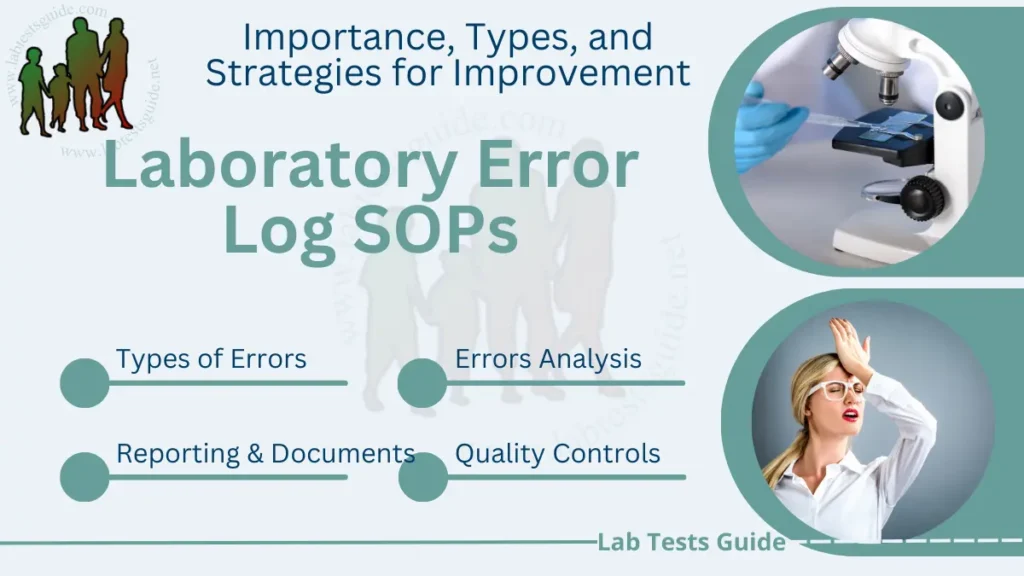Laboratory errors log SOPs is a tool used to document errors that occur in the laboratory. It is an essential part of the quality management system and helps to identify areas of improvement and minimize errors that could potentially harm patients.

The Error Log should contain detailed information about each error, including the type of error, the date and time it occurred, the person who reported it, and the steps taken to correct the error. The Error Log should be maintained in a secure location and accessible only to authorized personnel.
Laboratory Errors Types:
Errors in pathology laboratories can be classified into three main types: pre-analytical, analytical, and post-analytical errors.
- Pre-analytical errors
- Analytical errors
- Post-analytical errors
Pre-analytical Errors
Pre-analytical errors occur before the testing process begins and can be caused by errors in patient identification, incorrect sample collection, or sample transport.
Error Examples:
- Incomplete patient identification
- Inadequate sample labeling
- Incorrect sample collection site
- Inappropriate sample container or preservative
- Insufficient sample volume
- Delayed sample transport to the laboratory
- Incorrect sample handling or storage conditions
- Inappropriate sample preparation or processing
- Cross-contamination of samples
- Use of expired or degraded reagents
- Use of incorrect or outdated testing protocols
- Inadequate cleaning and maintenance of equipment
- Failure to calibrate or verify instrument performance
- Incorrect selection of tests for a given clinical indication
- Inappropriate test order or priority
- Incomplete or incorrect test requisition information
- Inadequate communication with other healthcare providers
- Inadequate patient preparation or instruction
- Inadequate documentation of patient history or medication use
- Inadequate training or supervision of laboratory personnel.
Analytical Errors
Analytical errors occur during the testing process and can be caused by instrument malfunctions, incorrect reagent preparation, or operator errors.
Error examples:
- Incorrect sample dilution or concentration
- Instrument malfunction or failure
- Inaccurate pipetting or measurement of reagents
- Contamination of reagents or equipment
- Inappropriate use of controls or standards
- Inadequate quality control monitoring
- Inadequate calibration or verification of instrument performance
- Use of expired or degraded reagents
- Interference from sample matrix or other substances
- Variability in temperature or humidity control
- Misinterpretation of assay results
- Failure to recognize or correct outliers or abnormal results
- Use of incorrect reference ranges or units of measurement
- Inadequate sensitivity or specificity of assays
- Inadequate assay validation or verification
- Misidentification of specimens or results
- Inadequate documentation or tracking of instrument maintenance or repairs
- Inadequate training or supervision of laboratory personnel
- Inadequate communication with other healthcare providers
- Inadequate implementation or adherence to laboratory policies and procedures.
Post-analytical Errors
Post-analytical errors occur after the testing process is complete and can be caused by errors in result reporting or result interpretation.
Error Examples:
- Incorrect result entry or transcription
- Delayed or missed result reporting
- Failure to report critical or abnormal results
- Failure to notify appropriate healthcare providers of critical or abnormal results
- Inadequate communication of results to patients or their families
- Inadequate follow-up on abnormal or unexpected results
- Inadequate tracking or documentation of result reporting or follow-up
- Inadequate documentation of result interpretation or significance
- Inadequate communication of testing limitations or caveats
- Misinterpretation of result trends or patterns
- Failure to correlate results with clinical information or history
- Inadequate consideration of pre-analytical or analytical factors that may affect result interpretation
- Failure to recognize or correct result discrepancies or conflicts
- Inadequate quality control monitoring of post-analytical processes
- Inadequate training or supervision of laboratory personnel
- Inadequate communication with other healthcare providers
- Inadequate implementation or adherence to laboratory policies and procedures related to post-analytical processes
- Inadequate documentation of follow-up actions taken in response to abnormal or unexpected results
- Inadequate communication or coordination with external laboratories or providers involved in result interpretation or follow-up
- Inadequate consideration of ethical, legal, or regulatory issues related to result reporting and follow-up.
Error Reporting and Documentation:
Procedures for reporting errors should be clearly defined and communicated to all laboratory personnel. It is essential to document all errors in the Error Log, including a description of the error, the potential impact on patient care, and the corrective actions taken.
Analysis of Errors:
A systematic approach to error analysis should be employed to identify the root cause of the error and the contributing factors. Recommendations for corrective actions should be made to prevent the error from recurring.
Quality Improvement Strategies:
Continuous quality improvement is essential for preventing errors in the pathology laboratory. Quality control procedures, staff training, and education are effective strategies for improving the quality of laboratory services.
Risk Management and Patient Safety:
The Error Log is an essential tool for risk management and patient safety. It helps to identify areas of risk in the laboratory and provides information that can be used to minimize errors that could potentially harm patients.
Legal and Ethical Considerations:
Disclosure of errors to patients and families is an ethical obligation, and laboratory personnel should be trained in how to handle these situations. Legal implications of errors should also be considered, and appropriate steps taken to minimize the risk of legal action.
Conclusion:
An Error Log is a critical component of the quality management system in pathology laboratories. It helps to identify areas of improvement, minimize errors that could potentially harm patients, and ensure that laboratory services are of the highest quality.
References:
- The College of American Pathologists. Laboratory Quality Control and Error Detection. Available from: https://www.cap.org/laboratory-improvement/quality-management/laboratory-quality-control-and-error-detection
- Brierley JD, Gospodarowicz MK, Wittekind C. TNM classification of malignant tumours. 8th ed. John Wiley & Sons; 2017.
- College of American Pathologists. Quality Management in Anatomic Pathology. Northfield, IL: College of American Pathologists; 2018.
- Karcher DS, Lehman CM. Clinical laboratory management. 2nd ed. Chicago, IL: American Society of Clinical Pathologists Press; 2013.
- Clinical and Laboratory Standards Institute. Quality management system: a model for laboratory services; approved guideline. 4th ed. CLSI document QMS01-A4. Wayne, PA: Clinical and Laboratory Standards Institute; 2011.
Possible References Used









